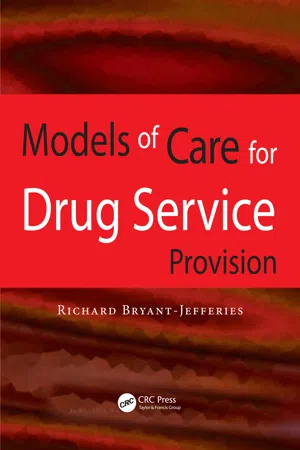
- 53 pages
- English
- ePUB (mobile friendly)
- Available on iOS & Android
Models of Care for Drug Service Provision
About This Book
Models of Care for Drug Service Provision encourages a greater understanding of the Models of Care system, and how it can be used in the interest of clients' health and well-being. It describes the different range of treatment responses that can be offered and illustrates the patient's journey through this model. It uses a fictitious account of a client with a drug problem to highlight the various technical aspects of treatments and issues that can commonly arise.
"This new book is a wonderful reminder that we are dealing first and foremost with human beings who are complex, vulnerable and who also happen to have a drug problem. Our treatment professionals need to be well informed, up to date and responsive to the needs of clients. They also need to be understanding, tolerant and resourceful. Models of Care for Drug Service Provision assists them by providing a framework within which to work and by helping to bind together the range of professionals and services into a system of care."
— Don Lavoie, National Treatment Agency
Frequently asked questions
Information
PART 1
An explanation of
Models of Care
CHAPTER 1
Introducing Models of Care
Implementation targets
Four tiers
- Tier 1: Non-substance misuse specific services requiring interface with drug and alcohol treatment.
- Tier 2: Open access drug and alcohol treatment services.
- Tier 3: Structured community-based drug treatment services.
- Tier 4 services: Residential services for drug and alcohol misusers:
- – Tier 4a: Residential drug and alcohol misuse specific services
- – Tier 4b: Highly specialist non-substance misuse specific services.
Tier 1 Non-substance misuse specific services requiring interface with drug and alcohol treatment
- a full range of healthcare (primary, secondary and tertiary), social care, housing, vocational and other services
- drug and alcohol screening, assessment and referral mechanisms to drug treatment services from generic, health, social care, housing and criminal justice services
- the management of drug misusers in generic health, social care and criminal justice settings (e.g. police custody)
- health promotion advice and information
- hepatitis B vaccination programmes for drug misusers and their families. (NTA, 2002, p. 17)
Tier 2 Open access drug and alcohol treatment services
- drug- and alcohol-related advice, information and referral services for misusers (and their families), including easy access or drop-in facilities
- services to reduce risks caused by injecting drug misuse, including needle exchange facilities (in drug treatment services and pharmacy-based schemes)
- other services that minimise the spread of blood-borne diseases to drug misusers, including service-based and outreach facilities
- services that minimise the risk of overdose and other drug- and alcohol-related harm
- outreach services (detached; peripatetic and domiciliary) targeting high-risk and local priority groups
- specialist drug a...
Table of contents
- Cover
- Title Page
- Copyright Page
- Contents
- Foreword
- About the author
- Acknowledgements
- Introduction
- Part 1 An explanation of Models of Care
- Part 2 The patient’s journey through Models of Care
- Part 3 Reflecting on the success of Models of Care for this patient
- Reflecting on Mark’s journey through Models of Care: a psychiatrist’s perspective
- Reflecting on Mark’s journey through Models of Care: a family therapy perspective
- Emerging themes: reflections of a nurse consultant
- Conclusion
- References
- Index